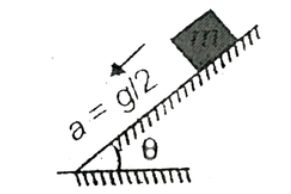A copper cube of mass 200g slides down an a rough inclined plane of inclination 37∘ at a constant speed Assume that any loss in mechanical energy goes into the copper block as thermal energy .Find the increase in the temperature of the block as if slides down through 60cm Specific head capacity of copper =420Jkg−1K−1
The correct Answer is:A, C
To solve the problem step by step, we will follow the principles of energy conservation and the definition of specific heat capacity.
Step 1: Identify the given data
- Mass of the copper cube, m=200g=0.2kg
- Distance slid down the incline, L=60cm=0.6m
- Angle of inclination, θ=37∘
- Specific heat capacity of copper, c=420J/kg/K
- Acceleration due to gravity, g=9.8m/s2
Step 2: Calculate the change in potential energy
The change in potential energy as the cube slides down the incline can be calculated using the formula:
ΔPE=mgh
where h is the height change. The height h can be calculated using:
h=Lsin(θ)
Substituting the values:
h=0.6m⋅sin(37∘)
Using sin(37∘)≈0.6:
h≈0.6⋅0.6=0.36m
Now, substituting h back into the potential energy formula:
ΔPE=0.2kg⋅9.8m/s2⋅0.36m
Calculating this gives:
ΔPE≈0.2⋅9.8⋅0.36≈0.7056J
Step 3: Relate the change in potential energy to thermal energy
Since the cube slides down at a constant speed, the loss in potential energy is converted into thermal energy gained by the copper block:
ΔPE=ΔQ
where ΔQ=mcΔT. Therefore,
0.7056J=0.2kg⋅420J/kg/K⋅ΔT
Step 4: Solve for the increase in temperature ΔT
Rearranging the equation to find ΔT:
ΔT=0.7056J0.2⋅420
Calculating the denominator:
0.2⋅420=84
Now substituting back:
ΔT=0.705684≈0.0084K
Step 5: Final result
The increase in temperature of the copper block is:
ΔT≈0.0084K or 8.4×10−3K
- Mass of the copper cube, m=200g=0.2kg
- Distance slid down the incline, L=60cm=0.6m
- Angle of inclination, θ=37∘
- Specific heat capacity of copper, c=420J/kg/K
- Acceleration due to gravity, g=9.8m/s2
The change in potential energy as the cube slides down the incline can be calculated using the formula:
ΔPE=mgh
where h is the height change. The height h can be calculated using:
h=Lsin(θ)
Substituting the values:
h=0.6m⋅sin(37∘)
Using sin(37∘)≈0.6:
h≈0.6⋅0.6=0.36m
Now, substituting h back into the potential energy formula:
ΔPE=0.2kg⋅9.8m/s2⋅0.36m
Calculating this gives:
ΔPE≈0.2⋅9.8⋅0.36≈0.7056J
Since the cube slides down at a constant speed, the loss in potential energy is converted into thermal energy gained by the copper block:
ΔPE=ΔQ
where ΔQ=mcΔT. Therefore,
0.7056J=0.2kg⋅420J/kg/K⋅ΔT
Rearranging the equation to find ΔT:
ΔT=0.7056J0.2⋅420
Calculating the denominator:
0.2⋅420=84
Now substituting back:
ΔT=0.705684≈0.0084K
The increase in temperature of the copper block is:
ΔT≈0.0084K or 8.4×10−3K
Topper's Solved these Questions
- BOOK - HC VERMA ENGLISHCHAPTER - CALORIMETRYEXERCISE - Short answer9videos
CALORIMETRY
- BOOK - HC VERMA ENGLISHCHAPTER - CALORIMETRYEXERCISE - Objetive - II6videos
CALORIMETRY
- BOOK - HC VERMA ENGLISHCHAPTER - CENTRE OF MASS, LINEAR MOMENTUM, COLLISIONEXERCISE - Objective -211videos
CENTRE OF MASS, LINEAR MOMENTUM, COLLISION
Similar Questions
A copper cube of mass 200g slides down an a rough inclined plane of inclination 37∘ at a constant speed. Assume that any loss in mechanical energy goes into the copper block as thermal energy .Find the increase in the temperature of the block as it slides down through 60cm. Specific heat capacity of copper =420Jkg−1K−1
View SolutionA copper cube of mass 200g slides down an a rough inclined plane of inclination 37∘ at a constant speed. Assume that any loss in mechanical energy goes into the copper block as thermal energy .Find the increase in the temperature of the block as it slides down through 60cm. Specific heat capacity of copper =420Jkg−1K−1
View SolutionA block of mass m slides down a rough inclined plane with an acceleration g2
 View Solution
View SolutionCalculate the amount of heat energy required to raise the temperature of 100 g of copper from 20∘C to 70∘C. Specific heat capacity of copper = 390 J kg−1K−1
View SolutionA ball is dropped on a floor from a height of 2.0m After the collision it rises up to a height of 1.5m. Assume that 40% of the mechanical energy lost goes as thermal energy into the ball. Calculate the rise in the temperature of the ball in the collision specific heat capacity of the ball is 800Jkg−1K−1
View SolutionA block of mass 1 kg slides down a rough inclined plane of inclination 60∘ starting from its top. If coefficient of kinetic is 0.5 and length of the plane d=2 m, then work done against friction is
View SolutionA copper block of mass 60kg is heated till its temperature is increased by 20∘C . Find the heat supplied to the block. Specific heat capacity of =0.09calg−1−C.
View SolutionA block of mass 250 g slides down an incline of inclination 370 with a uniform speed. Find the work done against the friction as the block slides through 1.0 m.
View SolutionA block slides down on inclined plane (angle of inclination 60∘ ) with an accelration g/2 Find the coefficient friction
 View Solution
View SolutionA ball is dropped on a floor from a height of 2.0m. After the collision it rises up to a height of 1.5m. Assume that 40% of the mechanical energy lost goes as thermal energy into the ball.Calculate the rise in the temperature of the ball in the collision. Heat capacity of the ball is 800JK−1
View Solution

